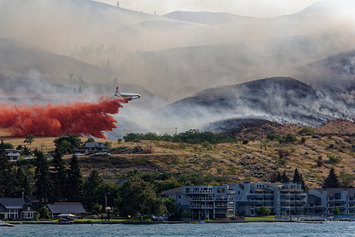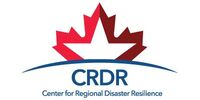Disaster Recovery
Past Projects
 C-130 dumping retardant during Washington's Chelan-Butte fire of 2015. Photo courtesy of Ben Brooks.
C-130 dumping retardant during Washington's Chelan-Butte fire of 2015. Photo courtesy of Ben Brooks.
CRDR to Study & Share Lessons Learned in Regional Wildfire Recovery
REPORT HERE
The Center for Regional Disaster Resilience is partnering with Northeastern University to identify lessons learned during the recovery from major fires in the region and share best practices that communities and citizens can use to prepare for fires and minimize their impact.
The project will look at the potentially increasing impact of wildfires on critical infrastructures, help identify lessons learned during the recovery from major fires in the region and share best practices that agencies, business & industry and communities can use to prepare for fires and minimize their impact to the infrastructures that support them.
The Pacific Northwest is home to forests that surround numerous urban, suburban and rural communities. Changes in the climate, weather patterns and the close proximity of homes and industry to forests are resulting in fires causing increasingly higher damage to critical infrastructure and communities.
More than 1 million acres burned across Washington State in 2015, the worst fire season in the state's history. In 2016, the Fort McMurray Fires in Northern Alberta destroyed 2,400 homes and displaced thousands of citizens. The fires became the Canada's costliest natural disaster. The human and financial toll of these disasters can take years to recover from and the new "normal" might not be what the community was before a fire.
Wildfires cross local, state and national political borders and require regional federal coordination. Recovery efforts are typically left to the individual jurisdictions with assistance from the state or provincial and federal governments. How to allocate and use this assistance can be a challenge for communities.
Through the grant, the CRDR will seek to:
- Identify lessons learned during the recovery from major fires in the region. This includes the efforts communities have undertaken to rebuild or relocate infrastructure
- Highlight the impacts to critical infrastructure that were impacted by fires and the challenges related to bringing those resources back online
- Look specifically for similarities and differences associated with wildland fires that do or do not impact urban areas
- Conduct one-on-one interviews with experts and stakeholders responsible for the response and recovery efforts in the region impacted by major wildfires
- Conduct or participate in a day long workshop
- Develop a summary issue document of issues and recommendations that will be combined with the efforts
The CRDR is working in partnership with the Meridian Institute, which is leading the project and investigating the impacts of wildland fires in the Eastern United States, specifically the fire that impacted Gatlinburg, Tennessee.
REPORT HERE
The Center for Regional Disaster Resilience is partnering with Northeastern University to identify lessons learned during the recovery from major fires in the region and share best practices that communities and citizens can use to prepare for fires and minimize their impact.
The project will look at the potentially increasing impact of wildfires on critical infrastructures, help identify lessons learned during the recovery from major fires in the region and share best practices that agencies, business & industry and communities can use to prepare for fires and minimize their impact to the infrastructures that support them.
The Pacific Northwest is home to forests that surround numerous urban, suburban and rural communities. Changes in the climate, weather patterns and the close proximity of homes and industry to forests are resulting in fires causing increasingly higher damage to critical infrastructure and communities.
More than 1 million acres burned across Washington State in 2015, the worst fire season in the state's history. In 2016, the Fort McMurray Fires in Northern Alberta destroyed 2,400 homes and displaced thousands of citizens. The fires became the Canada's costliest natural disaster. The human and financial toll of these disasters can take years to recover from and the new "normal" might not be what the community was before a fire.
Wildfires cross local, state and national political borders and require regional federal coordination. Recovery efforts are typically left to the individual jurisdictions with assistance from the state or provincial and federal governments. How to allocate and use this assistance can be a challenge for communities.
Through the grant, the CRDR will seek to:
- Identify lessons learned during the recovery from major fires in the region. This includes the efforts communities have undertaken to rebuild or relocate infrastructure
- Highlight the impacts to critical infrastructure that were impacted by fires and the challenges related to bringing those resources back online
- Look specifically for similarities and differences associated with wildland fires that do or do not impact urban areas
- Conduct one-on-one interviews with experts and stakeholders responsible for the response and recovery efforts in the region impacted by major wildfires
- Conduct or participate in a day long workshop
- Develop a summary issue document of issues and recommendations that will be combined with the efforts
The CRDR is working in partnership with the Meridian Institute, which is leading the project and investigating the impacts of wildland fires in the Eastern United States, specifically the fire that impacted Gatlinburg, Tennessee.
City of Seattle Disaster Recovery Plan
The City of Seattle Office of Emergency Management (OEM) is embarking on a new phase of planning for all-hazards disaster recovery that will address questions such as those above. The objective is to increase the community’s resilience to the impacts of a major earthquake or other disaster, and for the City, its partners, and community members to be better prepared to manage recovery and redevelopment in the days, months, and years following a disaster and immediate response efforts. The project prioritizes two outcomes:
1. A Disaster Recovery Plan will address short- and long-term recovery priorities and provide guidance for the restoration of critical community functions, public services, vital resources, facilities, programs, and infrastructure. The Plan will establish a common playbook and menu of pre-considered options to support effective, efficient, and agile recovery efforts, identifying what efforts and investments will be needed to repair, reconstruct, rebuild, and reconstitute the essential segments of the community. It will prepare key stakeholders from the public, non-profit, and private sectors to work together, with clear roles, responsibilities, and decision-making processes.
2. The Disaster Recovery Task Force will provide guidance and resources for short- and long-term recovery efforts. Composed of representatives of government, business, non-profit organizations, and others, the Task Force will meet on an ongoing basis to maintain a current view of recovery priorities and to ensure the group is ready to provide expert advice in a coordinated fashion when a disaster strikes.
The planning process, the Disaster Recovery Plan, and the ongoing work of the Task Force will build the relationships, common understanding, and expertise that will be needed to recover in a way that builds a more resilient infrastructure and a more resilient community.
Click here for more info
The City of Seattle Office of Emergency Management (OEM) is embarking on a new phase of planning for all-hazards disaster recovery that will address questions such as those above. The objective is to increase the community’s resilience to the impacts of a major earthquake or other disaster, and for the City, its partners, and community members to be better prepared to manage recovery and redevelopment in the days, months, and years following a disaster and immediate response efforts. The project prioritizes two outcomes:
1. A Disaster Recovery Plan will address short- and long-term recovery priorities and provide guidance for the restoration of critical community functions, public services, vital resources, facilities, programs, and infrastructure. The Plan will establish a common playbook and menu of pre-considered options to support effective, efficient, and agile recovery efforts, identifying what efforts and investments will be needed to repair, reconstruct, rebuild, and reconstitute the essential segments of the community. It will prepare key stakeholders from the public, non-profit, and private sectors to work together, with clear roles, responsibilities, and decision-making processes.
2. The Disaster Recovery Task Force will provide guidance and resources for short- and long-term recovery efforts. Composed of representatives of government, business, non-profit organizations, and others, the Task Force will meet on an ongoing basis to maintain a current view of recovery priorities and to ensure the group is ready to provide expert advice in a coordinated fashion when a disaster strikes.
The planning process, the Disaster Recovery Plan, and the ongoing work of the Task Force will build the relationships, common understanding, and expertise that will be needed to recover in a way that builds a more resilient infrastructure and a more resilient community.
Click here for more info
Post-Disaster Recovery Seminar: Lessons Learned from Hurricane Isaac
May 5 and 7, 2014
Several cities, counties and the state of Washington are currently in various stages of developing disaster recovery plans. Recovery planning is a rather new topic that very few jurisdictions have experience in. October 2013, PNWER joined a delegation of seven representatives from the region and visited Louisiana to learn about best practices in recovery planning. One topic of importance they were trying to understand is how the National Disaster Recovery Framework would be utilized during recovery, which was a major benefit to the St. John's Parrish in Louisiana. As a result of this informative visit, the region invited two key leaders to come to the Puget Sound region to share their experience with our region. Click here for report
May 5 and 7, 2014
Several cities, counties and the state of Washington are currently in various stages of developing disaster recovery plans. Recovery planning is a rather new topic that very few jurisdictions have experience in. October 2013, PNWER joined a delegation of seven representatives from the region and visited Louisiana to learn about best practices in recovery planning. One topic of importance they were trying to understand is how the National Disaster Recovery Framework would be utilized during recovery, which was a major benefit to the St. John's Parrish in Louisiana. As a result of this informative visit, the region invited two key leaders to come to the Puget Sound region to share their experience with our region. Click here for report
Regional Recovery Interdependencies Workshop, WA Homeland Security Region 6, 2012
This large scale regional workshop hosted by Microsoft, focused on business recovery and business resumption for the Puget Sound region following a major earthquake. The workshop explored the issues of infrastructure, government, physical security, employees/customers and suppliers. It was designed in three phased breakouts exploring: A) What would keep business from reopening; B) What could be done ahead of time to reduce the impact and to speed business resumption; and C) What should be included in government recovery plans to facilitate business resumption? As part of this effort, PNWER hosted King County, Pierce County, Snohomish County and city of Seattle leadership in meetings to encourage more regional collaboration and information sharing on disaster recovery planning. Click here for report
This large scale regional workshop hosted by Microsoft, focused on business recovery and business resumption for the Puget Sound region following a major earthquake. The workshop explored the issues of infrastructure, government, physical security, employees/customers and suppliers. It was designed in three phased breakouts exploring: A) What would keep business from reopening; B) What could be done ahead of time to reduce the impact and to speed business resumption; and C) What should be included in government recovery plans to facilitate business resumption? As part of this effort, PNWER hosted King County, Pierce County, Snohomish County and city of Seattle leadership in meetings to encourage more regional collaboration and information sharing on disaster recovery planning. Click here for report

